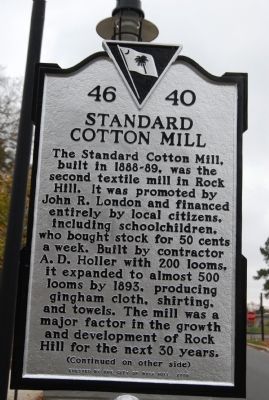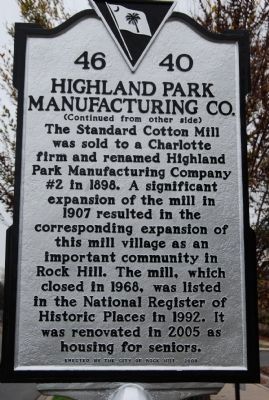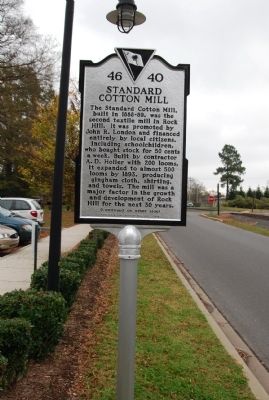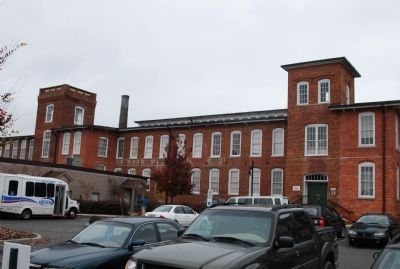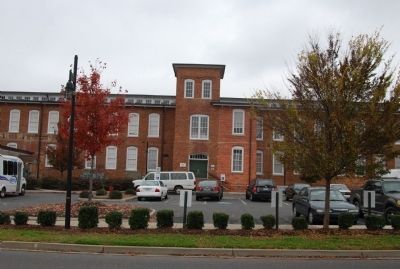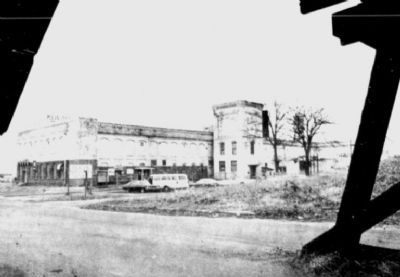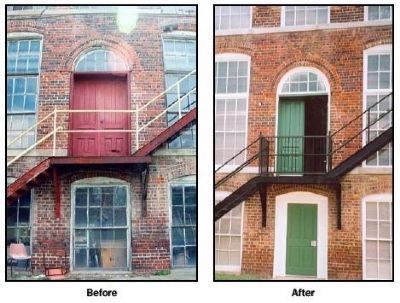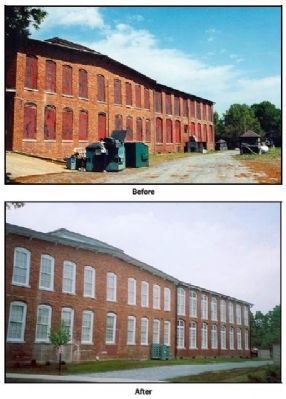Rock Hill in York County, South Carolina — The American South (South Atlantic)
Standard Cotton Mill / Highland Park Manufacturing Co.
Inscription.
Erected 2008 by City of Rock Hill. (Marker Number 46-40.)
Topics. This historical marker is listed in these topic lists: Industry & Commerce • Notable Buildings. A significant historical year for this entry is 1893.
Location. 34° 55.218′ N, 81° 0.648′ W. Marker is in Rock Hill, South Carolina , in York County. Marker is on Standard Street, 0.1 miles west of High Street, on the left when traveling east. Touch for map. Marker is at or near this postal address: 369 Standard Street, Rock Hill SC 29730, United States of America. Touch for directions.
Other nearby markers. At least 10 other markers are within walking distance of this marker. Sims Home Site (approx. ¼ mile away); Rock Hill High School (approx. half a mile away); St. Anne's Parochial School (approx. 0.6 miles away); The White Home (approx. ¾ mile away); East Town Neighborhood (approx. ¾ mile away); a different marker also named White Home (approx. ¾ mile away); Water Trough (approx. ¾ mile away); The "3C's" Railroad (approx. ¾ mile away); Upper Land's Ford Road (approx. ¾ mile away); First Presbyterian Church / Church Leaders (approx. 0.8 miles away). Touch for a list and map of all markers in Rock Hill.
Also see . . . South Carolina Department of Archives and History. The Highland Park Manufacturing Plant and Cotton Oil Complex represents an important element in the development of the textile industry in Rock Hill and in the rapid growth of the city during the period from 1881 to 1920. (Submitted on November 27, 2009, by Michael Sean Nix of Spartanburg, South Carolina.)
Additional commentary.
1. Highland Park Manufacturing Plant and Cotton Oil Complex
The Highland Park Manufacturing Plant and Cotton Oil
Complex is an unusual collection of industrial buildings in eastern Rock Hill. The complex includes the Highland Park Manufacturing Plant (1888-89), which was the second major textile mill in Rock Hill, the Highland Park Cotton Oil Mill (1902), and the Highland Park Cotton Oil Mill Office (1902). The original mill is located on Standard Street. The Oil Mill and Office are located on White Street. Surrounding the original mill are portions of the mill village, which is not included in the nomination. The buildings are described below:
1. Highland Park Manufacturing Plant, 869 Standard Street. Constructed in 1888-89 by Rock Hill contractor Captain A.D. Holler, the mill is a large rectangular brick building with a number of additions. The original portion, completed in 1889 as the Standard Mill, consisted of the present three-story tower and a two-story block of twelve bays to the left and eleven bays to the right (east). In 1907, the building was expanded with a four-story tower at the west end of the original block and an additional twenty-two bays to the west. There are one-story buildings to the rear and a tall, round smokestack. The original tower has a low hip roof. The third level has two windows to the front and one to each side, all with six-over-six lights and brick hoods. The second level has a double window and the first a modern metal door. The original block
has a frame monitor along the roof ridge with a low gable roof line. There are cornice brackets and the windows have segmental arches. Many of the windows have been bricked-in or covered with wood. The four-story tower has a flat roof with recessed brick panels near the top and one window on each level with masonry sills. There is a two-story addition to the right rear (northeast), one and two-story additions to the left rear (northwest), rectangular structures attached at right rear, and a water tower at the northeast corner of the property. The front facade is partially obscured by an attached modern one-story brick structure.
2. Highland Park Cotton Oil Mill, 732 East White Street. This building, which faces the mill across the railroad tracks and streets, is a two-story rectangular brick building with a four-story tower. The tower was originally placed in the center of the building, but the left (east) wing of the building has been demolished, with walls partially standing. To the rear of the demolished section is a wood frame storage attachment. The tower has a truncated-hip metal-covered roof, single windows with segmented arched openings at the third and fourth floors, and paired windows on the second level. The first level has an entrance with rounded-arch opening, fanlight, and corbelled hood. There are eight bays to the right of the tower. The windows have segmental
arches and masonry sills. The second level windows have been infilled with plywood. In the third bay to the right of the tower, each level has paired doors with fanlight and a corbelled hood with a rounded arched opening. There is a modern metal canopy on the facade at first level.
3. Highland Park Cotton Oil Mill Office, 737 East White Street. This rectangular brick building is located directly across White Street from the Oil Mill. It has a slate-covered hip roof with metal ridge caps and a central exhaust vent. The windows have six-over-six lights and segmental arched openings. The shed porch extends across the facade and has wood posts with braces. There is a small brick addition to the left (west) with a flat roof and a frame addition to the right (east). There is a detached storage building to the east which is noncontributing.
The water tower and smokestack associated with the Highland Park Manufacturing Plant date from an early period of use of the facility and are contributing structures.
1. A brick building to the rear of the Highland Park Manufacturing Plant, bordering on the rear of the property on Steele Street. This building dates from a later time period than the mill building.
2. A large warehouse building to the west of the Highland Park Manufacturing Plant. This building, of frame construction, is of later construction and
does not share design elements with the mill building.
3. A small metal storage building to the east of the Highland Park Cotton Oil Mill Office.
The Cotton Oil Seed House, which stood behind the oil Mill building, was demolished in August 1990. The complex is within the property type Textile Mill Buildings and Related Buildings of the multiple property submission Historic Properties of Rock Hill.
Significance
The Highland Park Manufacturing Plant and Cotton Oil Complex represents an important element in the development of the textile industry in Rock Hill and in the rapid growth of the city during the period from 1881 to 1920. It is also significant as an unusually intact group of industrial buildings related to several products of the cotton crop which was abundant at that time, and as an example of industrial architecture.
With the successful completion and operation of the Rock Hill Cotton Factory (1881), it became evident that the idea of bringing textile manufacturing to Rock Hill was both feasible and profitable. The Standard Cotton Mill was the second effort, and was entirely a local investment. The effort was led by John R. London, who was a successful merchant, farmer, banker, and politician. The venture was undertaken with the sale of stock to a wide spectrum of citizens. To make it easy to invest, shares were sold on
time for payments of fifty cents a week. Even school children pooled their money and invested. With all stock successfully subscribed to local investors in 1887, construction was underway in 1888, and the mill was completed in February 1889 with 200 looms. Contractor for the project was Captain A.D. Holler, who built most of the textile mills of the city. The mill was a success, and6many small investors soon earned a dividend of ten per cent a year. The plant was expanded to 300 looms in 1891 and to 486 by 1893. The initial Board included John R. London, President, P.C. Poag, A. Friedheim, T.A. Crawford, J.B. Johnson, W.J. Roddey, W.J. Rawlinson, R.T. Fewell, and A.E. Smith. After the death of Poag, W.L. Roddey became a Board member. These men were mostly merchants and business leaders, and all were local residents. The products of the mill were gingham goods, shirting, and towels. In 1898, the Standard was sold to a Charlotte firm and became the Highland Park Manufacturing Company #2. In 1902, the Cotton Oil Mill and Office were built. They were part of a larger complex of buildings, including a gin and seed house, all of which have been demolished. In 1907, the Highland Park Mill was expanded significantly. The mill village continued to grow in all directions from the mill. The community included chapels started by the Presbyterians (1890), Baptists (1909) and Methodists (1916).
The mill operated until 1968, and is now occupied by Plej's Textile Outlet as a warehouse and limited manufacturing facility. The Cotton Oil Mill and Office were used for retail space for a number of years, and are now vacant. The Seed House was demolished in September 1990.
The Highland Park complex is significant for its architecture and for the fact that such a grouping of buildings related to cotton manufacturing and processing seldom survives. The rectangular mill building with central towers was a typical design for textile mills in the South Carolina Piedmont. Although there have been additions over the years, the original complex and its 1907 addition are well preserved. The complex is also significant for the impact it had on the growth and development of Rock Hill. The development of the textile industry led to a rapid expansion of the City of Rock Hill between 1881 and 1920. The Standard Mill, later Highland Park, was important as the second mill in Rock Hill. It also helped to set the pattern of investment by local leaders and citizens in the creation of the industry and of the mill village system. (Source: National Register nomination form.)
— Submitted January 29, 2010, by Brian Scott of Anderson, South Carolina.
Credits. This page was last revised on June 16, 2016. It was originally submitted on November 27, 2009, by Michael Sean Nix of Spartanburg, South Carolina. This page has been viewed 1,918 times since then and 103 times this year. Photos: 1, 2, 3, 4, 5. submitted on November 27, 2009, by Michael Sean Nix of Spartanburg, South Carolina. 6, 7, 8. submitted on January 29, 2010, by Brian Scott of Anderson, South Carolina. • Bill Pfingsten was the editor who published this page.
